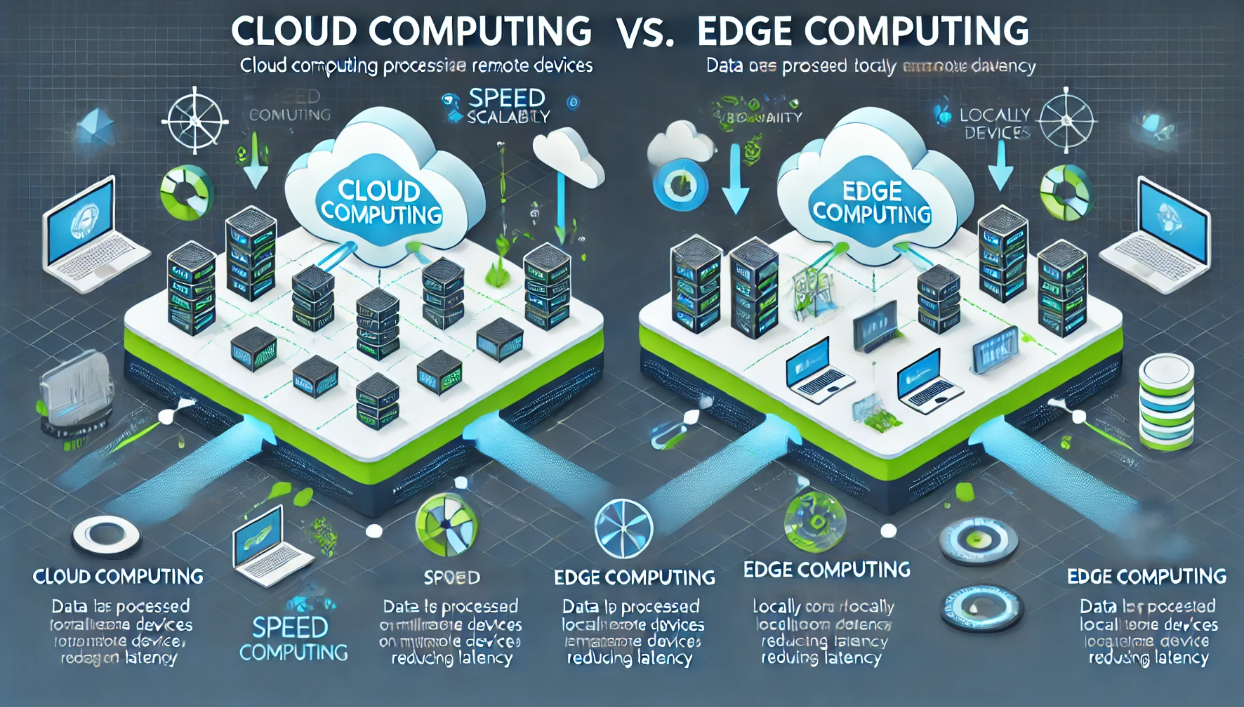The Rise of Edge Computing: What It Means for Businesses
Introduction
As data volumes skyrocket and real-time processing becomes critical, edge computing is emerging as a game-changer. Businesses no longer have to rely solely on centralized cloud servers—instead, edge computing allows data to be processed closer to the source, improving speed, security, and efficiency.
Key Benefits of Edge Computing:
✅ Faster Data Processing – Reduces latency for real-time applications.
✅ Improved Security & Privacy – Keeps sensitive data local instead of sending it to the cloud.
✅ Optimized IoT Performance – Enables smart devices to process data faster.
✅ Lower Bandwidth Costs – Reduces the need for constant cloud communication.
By the end of this guide, you’ll understand why edge computing matters and how it’s transforming businesses in 2025 and beyond.
⚡ 1. What is Edge Computing?
Traditional Cloud vs. Edge Computing
Cloud Computing: Data is sent to a centralized data center for processing.
Edge Computing: Data is processed locally, near the source (e.g., IoT devices, on-premises servers, 5G base stations).
Example:
A self-driving car can’t afford network latency—it must process sensor data instantly. Instead of waiting for cloud processing, edge computing enables real-time decisions within milliseconds.
How Edge Computing Works
✔️ Data is collected from IoT devices or sensors.
✔️ Edge devices process data locally (routers, gateways, micro data centers).
✔️ Only critical data is sent to the cloud, reducing bandwidth usage.
✅ Result? Faster response times, reduced cloud dependency, and real-time insights.
2. How Edge Computing Reduces Latency
Why Latency Matters?
Latency (delay in data transfer) is a major problem in industries that require instant decision-making.
Cloud Processing: Data travels hundreds or thousands of miles to a central data center before a response is sent.
Edge Processing: Data is processed locally (within milliseconds), eliminating long-distance communication delays.
Real-World Example:
✔️ Autonomous Vehicles – Edge AI processes camera & sensor data in real time for collision avoidance.
✔️ Smart Factories – Manufacturing robots adjust operations instantly without waiting for cloud instructions.
✔️ Telemedicine – Remote surgeries require ultra-low latency to ensure real-time robotic precision.
✅ Result? Faster data processing, better user experiences, and instant decision-making.
3. How Businesses Benefit from Edge Computing
Industry Use Cases
Smart Manufacturing
✔️ Predictive Maintenance – Edge AI detects machine failures before they happen.
✔️ Automated Quality Control – Cameras & sensors analyze defective products in real time.
Autonomous Vehicles & Smart Cities
✔️ Traffic Management – Edge sensors analyze road conditions & optimize traffic flow.
✔️ Self-Driving Cars – Process data locally to react faster than cloud-based systems.
Healthcare & Telemedicine
✔️ AI-Powered Diagnosis – Local edge servers analyze MRI scans instantly.
✔️ Remote Patient Monitoring – IoT health devices process vitals in real-time for early alerts.
Retail & Smart Stores
✔️ Checkout-Free Shopping – Cameras & AI sensors detect items purchased without human intervention.
✔️ Customer Behavior Analysis – Edge computing tracks foot traffic & optimizes store layouts.
Environmental & Energy Management
✔️ Smart Grid Optimization – Sensors detect power fluctuations and balance energy loads efficiently.
✔️ IoT-Based Farming – Smart irrigation adjusts water usage based on soil moisture in real time.
✅ Result? Edge computing enhances efficiency, reduces operational costs, and improves customer experiences.
4. The Role of Edge Computing in IoT Growth
Why Edge Computing is Crucial for IoT?
By 2025, there will be over 75 billion IoT devices globally. If every device constantly sent data to the cloud, it would:
❌ Overload networks
❌ Increase latency
❌ Raise cloud storage costs
Edge computing enables IoT devices to:
✔️ Process data locally (e.g., security cameras analyze motion instantly).
✔️ Reduce cloud dependency (send only necessary data).
✔️ Enhance security (keep sensitive data within local networks).
Example:
A smart thermostat learns user preferences and adjusts temperature locally without needing to communicate with a remote cloud server.
✅ Result? Faster device responses, reduced bandwidth costs, and energy-efficient IoT ecosystems.
5. Security & Privacy Advantages of Edge Computing
How Edge Computing Improves Security
✔️ Less Data in Transit – Minimizes exposure to cyber threats.
✔️ Local Data Processing – Reduces risk of cloud breaches.
✔️ Zero-Trust Architecture – Each device authenticates requests before sharing data.
Example:
A financial institution using edge computing can analyze transactions locally to detect fraud instantly, reducing reliance on cloud-based fraud detection systems.
✅ Result? Enhanced privacy, security, and compliance with GDPR & data regulations.
6. The Future of Edge Computing
What’s Next for Edge Computing?
AI-Driven Edge Devices – Smart AI chips will process data in milliseconds.
5G-Powered Edge Networks – Ultra-fast 5G speeds will enable near-instant connectivity.
Blockchain & Edge Security – Decentralized security to prevent cyberattacks.
Serverless Edge Computing – Cloud providers will offer edge-based FaaS (Functions as a Service).
Key Cloud Providers Investing in Edge Computing:
✔️ Amazon AWS Wavelength – Bringing compute power to 5G networks.
✔️ Microsoft Azure IoT Edge – AI-powered edge analytics.
✔️ Google Distributed Cloud Edge – Low-latency computing for smart devices.
✅ Result? Edge computing will become faster, smarter, and more integrated into daily business operations.
Final Thoughts: Why Edge Computing Matters
For Businesses: Lower costs, faster services, and better security.
For IoT & Smart Devices: Low-latency processing and real-time automation.
For Security & Compliance: Local data processing = reduced cyber threats.
For Cloud Optimization: Less bandwidth use, lower cloud storage costs.
⚡ Edge computing isn’t replacing the cloud—it’s making it smarter, faster, and more efficient.
✅ Next Steps?
Invest in edge-capable devices & infrastructure.
Optimize IoT solutions with local data processing.
Secure edge deployments with AI-driven security.
The future of business is happening at the edge. Are you ready?
Would you like a deep dive into Edge AI or 5G-powered edge computing? Let me know!

